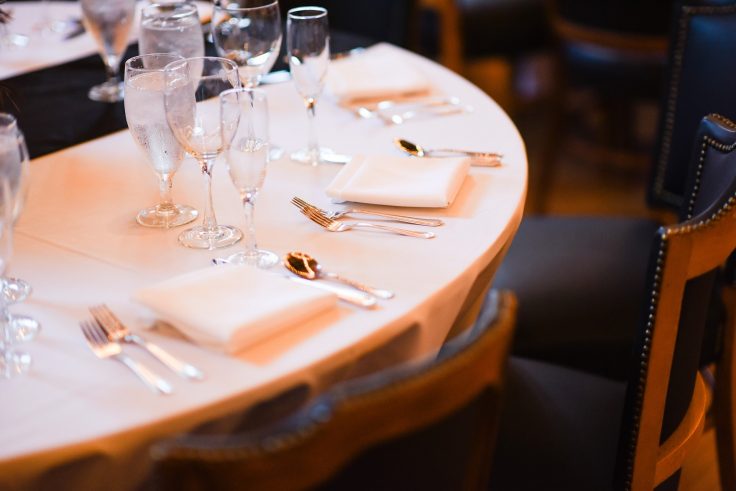"All of us want to be made to feel special, to be known and acknowledged," proclaims restaurant industry veteran Michael Cecchi-Azzolina in his dishy memoir, Your Table Is Ready. "This is where the power of the great maîtres d’hotel comes from."
It is but one of the book’s theories that ring true even for those who seldom fine-dine but understand human nature and/or have an inkling of what a maître d’hotel job entails ("hotel master," a title popular in the 1700s and truncated by Americans circa 1940). A maître d’ is no mere greeter at the Gap; that almost-always male professional sets the tone at point of entry, takes reservations, dispenses tables and favors, trains staff, monitors service, alerts staff to incoming critics and health inspectors, knows when to disappear (such as an impending disaster of overbooking), and has the cojones to direct a different performance every night.
With more than three decades of theater craft simultaneous with his rising through the ranks from waiter to general manager, Cecchi-Azzolina fits the bill. If you know your heyday New York restaurants, be impressed: He served in various capacities at the Water Club, the River Café, La Rousse, Minetta Tavern, Bobo, Raoul’s, and Le CouCou. That he was the first real maître d’ at any of Stephen Starr’s dozens of restaurants is a laurel he figures he deserved. He explains why: "I know New York and New Yorkers. I know what they want. … I don’t bullshit. I know the downtown dining scene." He also knew the rules and broke them—chatting, drinking, and sitting with guests.
Oh, he misbehaved in other ways. Drugs, shift drinking, and debauchery were the norm in the 1980s and ’90s, no matter how high-falutin’ the establishment. Cecchi-Azzolina describes his cohorts as mentors, sex addicts, survivors of abuse, ragers, perfectionists, and narcissists, via monikers such as The Ex-Mormon, Thespian Bartender, Mr. Debonair, Girl, Suspenders, Iron Bottoms, The Jock, and Queen Mother. Yet these were, and are, his people, he says, because they were "addictive-personality" misfits who banded together as a team when it mattered.
Not to worry. The author drops plenty of actual celebrity names and doings throughout the chapters. Calvin Klein hobnobbing with Roy Cohn, Malcolm Forbes, and their "boys du jour." Brooke Shields, who blurbed for the book, marking her 18th birthday by inviting restaurant employees to the dance floor. Harvey Keitel, post Pulp Fiction premiere with Uma Thurman at his table, torturing him with questions about a veal chop on the menu—including whether it has a bone—only to order steak. Ivana Trump, interviewing him for a job at the Plaza he didn’t want. Lou "Effing" Reed, at the bar.
How did New York restaurants become so populated by the rich and famous, anyway? The author pins it precisely to the 1980 closing of Studio 54. Beautiful people needed somewhere to go and be seen, which underscores the author’s earlier proclamation. Comfort would become part of the draw as well. Raoul’s was able to remain open in the aftermath of 9/11, he says, à la Cheers—and was beloved as a place of solace and normalcy for staff as well as guests.
Insider terminology is patiently explained, such as FOH (Front of House); touching a table (when a person of authority visits each table); and a wine whale (someone who spends big on vino). Cecchi-Azzolina is at his assessment best, however, when he raises the curtain on FOH practices and debunks assumptions. A sampler:
Tipping a maître d’ isn’t necessary. Twenty bucks won’t get you much, and $100, the gold standard, will almost certainly snag a table for a walk-in.
Ten minutes is inexcusable and can seem like forever when a diner is waiting for a glass of wine, which is typically the first interaction between waiter and table.
The customer is always right? Wrong: "It has created a generation of entitled, demanding, obstreperous, rude, truculent and surly people who think they can treat managers and servers like shit and get away with it," he says. "Not only do they get away with it, but they are usually rewarded with free drinks, free desserts, and at times completely comped dinners."
Why do folks with dinner reservations have to wait up to 45 minutes for a table? He blames cell phones. Guests who are done with their meals start pulling out their phones to order a ride or show each other photos, the timing of the dining room goes off the rails.
The pandemic forced the end of many restaurants and careers in service, including Cecchi-Azzolina’s. But he recognizes an upside: It "opened the eyes of many in this industry to rethink who we are … what we need to do," he says. "Those who stay are now able to ask for better pay and benefits." Even with long hours and the regrettable effect on significant others at home, he found he missed the life. So, he ends the book with a full-circle, bury-the-lede revelation.
"It’s time to let my guests know—their table is ready." He’s planning to open a restaurant of his own.
Your Table Is Ready: Tales of a New York City Maître D
by Michael Cecchi-Azzolina
St. Martin’s Press, 288 pp., $30
Bonnie S. Benwick, formerly of the Washington Post food section, is a freelance editor and recipe tester. You can find her on Instagram: @bbenwick.
